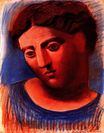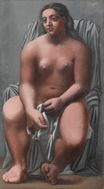©Pablo Picasso - Large Bather 1921
 |
 |
 |
 |
 |
 |
 |

Large Bather 1921
182x101cm oil/canvas
Paris, Musee de l'Orangerie
The image is only being used for informational and educational purposes
<< Previous G a l l e r y Next >>
From Paris, Musee de l'Orangerie:
In parallel with the avant-garde movements such as Abstraction and Constructivism that were developing in the second decade of the 20th century and the early 1920s, and alongside the Dadaist montages, a style of painting became established that took its inspiration from the old masters, with a more representational treatment of man and nature. Picasso, like other artists now in the Walter-Guillaume collection such as Derain, contributed to this movement that was called "the return to order" because of the classical aspect of their compositions. In this large-scale painting, Picasso represents a monumental seated female nude. This figure, with its massive sculptural proportions and drapery, recalls the canons of Antiquity while at the same time exaggerating them. There appear to be a number of sources here. In addition to Greek and Roman Antiquity, Picasso has turned to the masters of the past, and in particular to Ingres and Renoir. Following their example, he experimented with a strange style of Classicism that included distorted bodies and solid, heavy faces. What we see, in fact, with the emergence of these large bathers in Picasso’s work, is the reconstruction of a transcended and idealised Classical Antiquity. Paul Guillaume acquired this key work after 1930. It was then meticulously conserved by his widow Domenica, since it corresponded perfectly with her tastes and preferences in painting.